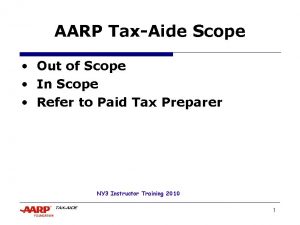Workshop Three The Scope of Markets Markets take














- Slides: 14

Workshop Three

The Scope of Markets • Markets take various forms, but they all enable buyers and sellers to exchange products - shops, auctions, newspapers, the internet… • Markets operate at local, national and global levels – housing, cars, insurance, foreign currencies, coffee… • More IT innovations, communications, transport and increasing similarities in tastes => more global markets (e. g. books, operations…)

The Role of Markets • Markets allocate resources. They move resources from products experiencing a decline towards those experiencing an increase in demand - popularity increases prices, higher prices encourage suppliers…(e. g. football versus snooker)

A Competitive Market => – many buyers and sellers – no restrictions on entry and exit – responds quickly to changes in consumer demand

Barriers to Entry… Þ obstacles or restrictions which make it difficult for a firm to enter a market : Legal barriers (franchises, licences, patients, copyrights…) Access to barriers and resources & outlets (soil, climate conditions, natural resources…) Cost barriers (high costs before economies of scale, transportation…) Advertising and reputation (large-scale advertising expenditure, brand names…)

Barriers to Exit… Þ obstacles or restrictions which make it difficult for a firm to exit a market : • Sunk costs (money spent on advertising, specialised capital equipment…) • Long-term contracts

• In reality, many markets are not very competitive with few suppliers exercising considerable market power • E. g. multinational coffee companies are such large buyers of coffee that they can dictate the prices they pay to coffee producers of Brazil, Ecuador, Indonesia, Vietnam and other developing countries

• The participants in markets -> – Consumers – Suppliers – The government – Environmental groups (firms, the government, households…) • Consumers: seek low prices, high quality and ready availability of goods • Governments: seek to ensure that products are provided in the right quantities & that poor have access to essential goods and services • Environmental groups: try to protect the environment and conserve wildlife

• Markets = interlinked • More demand for one product • => more demand for another product (complements) • <= less demand for other products (substitutes)

Market Structures • There are 4 main market structures: – Perfect competition – Monopoly – Monopolistic competition – Oligopoly More competition => more power to consumers Less competition => more power to producers

• Perfect competition => lots of independent buyers and sellers, an identical product, no barriers to entry and exit, no loyalty – -ve : little product variation, little opportunity for economies of scale, time lost comparing products – +ve : high levels of competition => keeps costs low & lots of choice, firms responsive to demand E. g. , a fair example is the dollar market (although some buyers and sellers are more powerful). More theoretical…

• A pure monopoly => one seller in the market, high barriers to entry, a unique product, possible supernormal profits in the long run – -ve : possible high prices, low quality, lack of choices – +ve : low costs (and prices), money for R&D and for innovation -> to deter other companies, offers certain stability, safety E. g. , Deutesche Post, Bank of England

• Monopolistic competition => many independent sellers, differentiated products (sometimes only slightly), easy entry and exit, loyalty – +ve : competition keeps profits to normal profit levels and prices ‘fair’, consumer choice – -ve : not lowest possible costs for firms E. g. hairdressers, bistros… One way of assessing the degree of market power in a market is to calculate the market share of the largest firms

• Oligopoly market => dominated by a few firms, high barriers to entry and exit, possible supernormal profits in the long run – -ve : difficult to predict how firms will behave, may engage in price or non-price competition or collude (price wars, restricted competition), high barriers – +ve : low costs, potential low prices E. g. tobacco, copper, oil, slat
 Take a bus or take a train
Take a bus or take a train Scope management pmp
Scope management pmp Use case diagram
Use case diagram Hình ảnh bộ gõ cơ thể búng tay
Hình ảnh bộ gõ cơ thể búng tay Ng-html
Ng-html Bổ thể
Bổ thể Tỉ lệ cơ thể trẻ em
Tỉ lệ cơ thể trẻ em Voi kéo gỗ như thế nào
Voi kéo gỗ như thế nào Glasgow thang điểm
Glasgow thang điểm Hát lên người ơi
Hát lên người ơi Môn thể thao bắt đầu bằng từ đua
Môn thể thao bắt đầu bằng từ đua Thế nào là hệ số cao nhất
Thế nào là hệ số cao nhất Các châu lục và đại dương trên thế giới
Các châu lục và đại dương trên thế giới Công thức tiính động năng
Công thức tiính động năng Trời xanh đây là của chúng ta thể thơ
Trời xanh đây là của chúng ta thể thơ


























